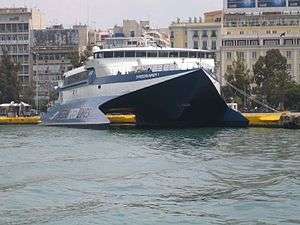HSC Sea Runner
 Speedrunner 1 in Piraeus | |
| History | |
|---|---|
| Name: |
|
| Owner: | Seajets |
| Operator: |
|
| Port of registry: |
|
| Route: | Laid-up |
| Builder: | Incat, Tasmania, Australia |
| Yard number: | 025 |
| Launched: | 1990 |
| Identification: |
|
| Honours and awards: | Hales Trophy (eastbound) |
| Notes: | [1][2][3] |
| General characteristics | |
| Type: | Wave piercing catamaran |
| Tonnage: | 185 - 230 |
| Length: | 73.6 m (241 ft) |
| Beam: | 26.3 m (86 ft) |
| Draught: | 2.5 m (8 ft 2 in) |
| Ramps: |
|
| Installed power: | 4 x GEC Alsthom Ruston 16RK 270 medium speed diesel engines (4 x 3,600kW at 750 rpm) |
| Propulsion: | Four steering water-jets |
| Speed: | 37 knots (69 km/h; 43 mph) |
| Capacity: | 450 passengers |
| Notes: | [4] |
HSC High Speed Jet is a 74 m (243 ft) ocean-going catamaran built in 1990 by International Catamarans (Incat) for the UK company, Hoverspeed and currently owned by Seajets. In 1990, she took the Hales Trophy for the fastest eastbound transatlantic journey, making the run, without passengers, in three days, seven hours and fifty-four minutes, averaging 36.6 knots (67.8 km/h).[2]
History
The ship's previous names were: Hoverspeed Great Britain (1990–2004), Emeraude GB (2004–2005), and Speedrunner 1 (2005–2008, when she sailed the Mediterranean Sea for Sea Containers Ltd and Aegean Speed Lines.[3]) Sea Runner (2008–2011) and Cosmos Jet (2011–2015, when she first began operating for Seajets).
HSC Hoverspeed Great Britain was replaced on the cross-channel route by MDV 1200 class ferries Superseacat One and Superseacat Two.
Specifications
Power is supplied by four Ruston 16RK270 V-16 marine diesel engines each with a 3500 kW (4694 hp) at 100 percent maximum continuous rating (MCR).
The 16RK270 engine has 16 cylinders, a 270 mm bore and a 305mm stroke, for a per cylinder displacement of 17.46L and a total displacement of 279.408L. The vessel in trials attained over 48 knots (89 km/h; 55 mph) on a 5-minute run; at full displacement it showed 45.20 knots (83.71 km/h; 52.02 mph) maximum and 44.08 knots (81.64 km/h; 50.73 mph) for a two-way average.
References
- ↑ "74 Metre Wave Piercing Catamaran". Incat. 2010. Retrieved 2010-05-01.
- 1 2 Micke Asklander (2010). "HSC Hoverspeed Great Britain (1990)". Fakta om Fartyg (Facts about Ships) (in Swedish). Retrieved 2010-05-01.
- 1 2 Michael Koefoed-Hansen (2010). "HSC Searunner". The Ferry Site. Retrieved 2010-05-01.
- ↑ "74m Wave Piercing Catamaran Car Passenger Ferry" (PDF). Incat Australia Pty Ltd. 2007. Retrieved 2010-05-01.
External links
| Records | ||
|---|---|---|
| Preceded by United States |
Atlantic Eastbound Record 1990–1998 |
Succeeded by Catalonia |